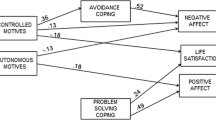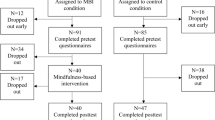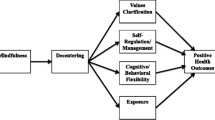Abstract
Objectives
Research has linked goal setting to improved well-being. Underlying mechanisms for how this works are not well understood. Prior research has explored the impact of interrelated goals (facilitation and conflict), client variables (anxiety and somatic symptoms), and anxiety-reducing procedures (meditation). The aim of this study was to use Reinforcement Sensitivity Theory to explore the relation between goal conflict, goal facilitation, anxiety, and mindfulness on somatic symptoms.
Methods
Undergraduate college students (n=454) completed self-report measures assessing interrelated goals, generalized anxiety, mindfulness, and somatic symptoms.
Results
Structural equation modeling (SEM) tested our primary hypothesized model that anxiety would mediate interrelated goals and somatic symptoms. While the model demonstrated acceptable fit (CFI = .946, RMSEA = .066, SRMR = .050), and full mediation for goal conflict and somatic symptoms was found, goal facilitation did not. An alternative model removed goal facilitation, and found an even better fit (CFI = .954, RMSEA = .067, SRMR = .046). Mindfulness was conceptualized as an exogenous variable and SEM tested the relationship between goal conflict, anxiety, and somatic symptoms. This model fit the data well (CFI = .940, RMSEA = .062, SRMR = .053). While mindfulness significantly predicted goal conflict, and goal conflict predicted anxiety, the indirect effect between mindfulness and anxiety was not significant.
Conclusions
Setting goals is a complex process; goal conflict was associated with increased levels of anxiety and somatic symptoms. Those who endorse mindful practices were less affected by goal conflict.




Similar content being viewed by others
References
Baer, R. A., Smith, G. T., Hopkins, J., Krietemeyer, J., & Toney, L. (2006). Using self-report assessment methods to explore facets of mindfulness. Assessment, 13(1), 27–45. https://doi.org/10.1177/1073191105283504.
Bagozzi, R., & Yi, Y. (1993). Multitrait-multimethod matrices in consumer research: Critique and new developments. Journal of Consumer Psychology, 2(2), 143–170 http://www.jstor.org/stable/1480648.
Bajaj, B., Robins, R., & Pande, N. (2016). Mediating role of self-esteem on the relationship between mindfulness, anxiety, and depression. Personality and Individual Differences, 96, 127–131. https://doi.org/10.1016/j.paid.2016.02.085.
Baron, R., & Kenny, D. (1986). The moderator-mediator variable distinction in social psychological research: Conceptual, strategic, and statistical consideration. Journal of Personality and Social Psychology, 51, 1173–1182.
Becerra-Garcia, J., & Robles Jurado, M. (2014). Behavioral approach system activity and self-reported somatic symptoms in fibromyalgia: An exploratory study. International Journal of Rheumatic Diseases, 17(1), 89–92. https://doi.org/10.1111/1756-185X.12034.
Bentler, P., & Wu, E. (2002). EQS 6.0 for windows user guide. [Computer software] Multivariate Software.
Bijttebier, P., Beck, I., Claes, L., & Vandereycken, W. (2009). Gray’s Reinforcement Sensitivity Theory as a framework for research on personality-psychopathology associations. Clinical Psychology Review, 29, 421–430. https://doi.org/10.1016/j.cpr.2009.04.002.
Bishop, S. R., Lau, M., Shapiro, S., Carlson, L., Anderson, N. D., Carmody, J., Segal, Z. V., Abbey, S., Speca, M., Velting, D., & Devins, G. (2004). Mindfulness: A proposed operational definition. Clinical Psychology: Science and Practice, 11, 230–241. https://doi.org/10.1093/clipsy.bph077.
Boudreaux, M. J., & Ozer, D. J. (2013). Goal conflict, goal striving, and psychological well-being. Motivation and Emotion, 37, 433–443. https://doi.org/10.1007/s11031-012-9333-2.
Byrne, B. M. (1998). Structural equation modeling with LISREL, P RELIS, and SIMPLIS: Basic concepts, applications, and programming. Lawrence Erlbaum.
Byrne, B. M. (2008). Structural equation modeling with EQS. Psychology Press.
Carmody, J., & Baer, R. A. (2008). Relationships between mindfulness practice and levels of mindfulness, medical and psychological symptoms and well-being in a mindfulness-based stress reduction program. Journal of Behavioral Medicine, 31(1), 23–33. https://doi.org/10.1007/s10865-007-9130-7.
Carver, C., & White, T. (1994). Behavioral inhibition, behavioral activation, and affective responses to impending reward and punishment: The BIS/BAS scales. Journal of Personality and Social Psychology, 67(2), 319–333. https://doi.org/10.1037/0022-3514.67.2.319.
Chen, Y., Yang, X., Wang, L., & Zhang, X. (2013). A randomized controlled trial of the effects of brief mindfulness meditation on anxiety symptoms and systolic blood pressure in Chinese nursing students. Nurse Education Today, 33(10), 1166–1172. https://doi.org/10.1016/j.nedt.2012.11.014.
Cheon, S. (2013). Differential effectiveness of sitting meditation program and movement meditation program in reducing college students’ cognitive and somatic trait anxiety. Doctoral dissertation, Syracuse University. https://surface.syr.edu/idde_etd/60.
Comrey, A., & Lee, H. (1992). A first course in factor analysis. Lawrence Erlbaum.
Cosme, D., & Wiens, S. (2015). Self-reported trait mindfulness and affective reactivity: A motivational approach using multiple psychophysiological measures. PLoS One, 10(3), e0119466. https://doi.org/10.1371/journal.pone.0119466.
Crane, C., Winder, R., Hargus, E., Amarasinghe, M., & Barnhofer, T. (2012). Effects of mindfulness-based cognitive therapy on specificity of life goals. Cognitive Therapy and Research, 36(3), 182–189. https://doi.org/10.1007/s10608-010-9349-4.
Davis, M. C., Zautra, A., Wolf, L. D., Tennen, H., & Young, E. (2015). Mindfulness and cognitive-behavioral interventions for chronic pain: Differential effects on daily pain reactivity and stress reactivity. Journal of Consulting and Clinical Psychology, 83(1), 24–35. https://doi.org/10.1037/a0038200.
Delle Fave, A., Brdar, I., Wissing, M. P., & Vella-Brodrick, D. A. (2013). Sources and motives for personal meaning in adulthood. The Journal of Positive Psychology, 8(6), 517–529. https://doi.org/10.1080/17439760.2013.830761.
Dickson, J. M., & Moberly, N. J. (2010). Depression, anxiety, and reduced facilitation in adolescents’ personal goal systems. Cognitive Therapy and Research, 34(4), 576–581. https://doi.org/10.1007/s10608-010-9307-1.
Dobrow, M. J., Orchard, M. C., Golden, B., Holowaty, E., Paszat, L., Brown, A. D., & Sullivan, T. (2008). Response audit of an Internet survey of health care providers and administrators: Implications for determination of response rates. Journal of Medical Internet Research, 10(4), e30. https://doi.org/10.2196/jmir.1090.
Feldman, G., Hayes, A., Kumar, S., Greeson, J., & Laurenceau, J. (2007). Mindfulness and emotion regulation: The development and initial validation of the Cognitive and Affective Mindfulness Scale-Revised (CAMS-R). Journal of Psychopathology and Behavioral Assessment, 29(3), 177–190. https://doi.org/10.1007/s10862-006-9035-8.
Field, A. (2005). Discovering statistics using SPSS. Sage.
Freund, A. M., Knecht, M., & Wiese, B. S. (2014). Multidomain engagement and self-reported psychosomatic symptoms in middle-aged women and men. Gerontology, 60(3), 255–262. https://doi.org/10.1159/000358756.
Gotink, R. A., Chu, P., Busschbach, J. J. V., Benson, H., Fricchione, G. L., & Hunink, M. G. M. (2015). Standardised mindfulness-based interventions in healthcare: An overview of systematic reviews and meta-analyses of RCTs. PLoS One, 10(4), e0124344. https://doi.org/10.1371/journal.pone.0124344.
Gray, J. A. (1976). The behavioral inhibition system: A possible substrate for anxiety. In M. P. Feldman & A. M. Broadhurst (Eds.), pp. 3-41. Theoretical and Experimental Bases of Behavior Modification (pp. 3-41). Wiley.
Gray, J. A., & McNaughton, N. (1996). The neuropsychology of anxiety: Reprise. In D. A. Hope (Ed.), Current Theory and research in motivation, Vol. 43. Nebraska Symposium on Motivation, 1995; Perspective on anxiety panic and fear (pp. 61–134). University of Nebraska Press.
Gray, J. A., & McNaughton, N. (2000). The neuropsychology of anxiety: An enquiry into the functions of the septo-hippocampal system. Oxford University Press. https://doi.org/10.1093/acpof:oso/9780198522713.001.00001.
Gray, J., Ozer, D., & Rosenthal, R. (2017). Goal conflict and psychological well-being: A meta-analysis. Journal of Research in Personality, 66(1), 27–37. https://doi.org/10.1016/j.jrp.2016.12.003.
Greeson, J. M., Toohey, M. J., & Pearce, M. J. (2015). An adapted, four week mind-body skills group for medical students: Reducing stress, increasing mindfulness, and enhancing self-care. EXPLORE, 11(3), 186–192. https://doi.org/10.1016/j.explore.2015.02.003.
Grossman, P., & Van Dam, N. T. (2011). Mindfulness, by any other name…: Trials and tribulations of sati in western psychology and science. Contemporary Buddhism, 12(1), 219–239. https://doi.org/10.1080/14639947.2011.564841.
Hayes, S. C., Strosahl, K. D., & Wilson, K. G. (2012). Acceptance and commitment therapy: The process and practice of mindful change (2nd ed.). Guilford Press.
Hu, L., & Bentler, P. M. (1999). Cutoff criteria for fit indexes in covariance structure analysis: Conventional criteria versus new alternatives. Structural Equation Modeling, 6(1), 1–55. https://doi.org/10.1080/10705519909540118.
Jackson, D. L. (2003). Revisiting sample size and number of parameter estimates: Some support for the N:q hypothesis. Structural Equation Modeling, 10(1), 128–141. https://doi.org/10.1207/S15328007SEM1001_6.
Keune, P., Bostanov, V., Hautzinger, M., & Kotchoubey, B. (2011). Mindfulness-based cognitive therapy (MBCT), cognitive style, and the temporal dynamics of frontal EEG alpha asymmetry in recurrently depressed patients. Biological Psychology, 88(2-3), 243–252. https://doi.org/10.1016/j.biopsycho.2011.08.008.
Kline, R. B. (2011). Principles and practice of Structural Equation Modeling (3rd ed.). Guilford Press.
Kocalevent, R., Hinz, A., & Brahler, E. (2013). Standardization of a screening instrument (PHQ-15) for somatization syndromes in the general population. BMC Psychiatry, 13, 91–99. https://doi.org/10.1186/1471-244X-13-91.
Kroenke, K., Spitzer, R. L., deGruy, F. V., & Swindle, R. (1998). 15-item patient health questionnaire. Retrieved from PsycTests. https://doi.org/10.1037/t19590-000.
Kroenke, K., Spitzer, R. L., Williams, J. B., & Löwe, B. (2010). The patient health questionnaire somatic, anxiety, and depressive symptom scales: a systematic review. General Hospital Psychiatry, 32(4), 345–359. https://doi.org/10.1016/j.genhosppsych.2010.03.006.
Lau, M. A., Bishop, S. R., Segal, Z. V., Buis, T., Anderson, N. D., Carlson, L., Shapiro, S., Carmody, J., Abbey, S., & Devins, G. (2006). The toronto mindfulness scale: Development and validation. Journal of Clinical Psychology, 62(12), 1445–1467. https://doi.org/10.1002/jclp.20326.
Little, T. D., Rhemtulla, M., Gibson, K., & Schoemann, A. M. (2013). Why the items versus parcels controversy needn’t be one. Multivariate Behavioral Research, 18(3), 285–300. https://doi.org/10.1037/a0033266.
Löwe, B., Decker, O., Müller, S., Brähler, E., Schellberg, D., Herzog, W., & Herzberg, P. Y. (2008). Validation and standardization of the Generalized Anxiety Disorder Screener (GAD-7) in the general population. Medical Care, 46(3), 266–274.
Mardia, K. V. (1970). Measures of multivariate skewness and kurtosis with applications. Biometrika, 57(3), 519–530. https://doi.org/10.2307/2334770.
Markarian, S. A., Pickett, S. M., Deveson, D. F., & Kariona, B. B. (2013). A model of BIS/BAS sensitivity, emotion regulation difficulties, and depression, anxiety, and stress symptoms in relation to sleep quality. Psychiatry Research, 210(1), 281–286. https://doi.org/10.1016/j.psychres.2013.06.004.
Matsunaga, M. (2008). Item parceling in structural equation modeling: A primer. Communication Methods and Measures, 2(4), 260–293. https://doi.org/10.1080/19312450802458935.
Miller, W., & Rose, G. (2009). Toward a theory of motivational interviewing. American Psychologist, 64(6), 527–537. https://doi.org/10.1037/a0016830.
Morris, L., Mansell, W., & McEvoy, P. (2016). The take control course: Conceptual rationale for the development of a transdiagnostic group for common mental health problems. Frontiers in Psychology, 7(99), 1–15. https://doi.org/10.3389/fpsyg.2016.00099.
Mrazek, M. D., Franklin, M. S., Phillips, D. T., Baird, B., & Schooler, J. W. (2013). Mindfulness training improves working memory capacity and GRE performance while reducing mind wandering. Psychological Science, 24(5), 776–781.
Muraven, M. (2017). Goal conflict in designing an autonomous artificial system. arXiv:1703.06354 [cs.AI]. aarxiv.org/abs/1703.06354.
Pickering, A., & Corr, P. (2008). J.A. Gray’s reinforcement sensitivity theory (RST) of personality. In G. Boyle, G. Matthews, & D. Saklofske (Eds.), The SAGE handbook of personality: Theory and assessment personality measurement and testing (pp. 239–255). Sage. https://doi.org/10.4135/9781849200462.n11.
Pielech, M., Vowles, K. E., & Wicksell, R. (2017). Acceptance and commitment therapy for pediatric chronic pain: Theory and application. Children (Basel), 4(2), 10. https://doi.org/10.3390/children4020010.
Podsakoff, P. M., MacKenzie, S. B., Lee, J.-Y., & Podsakoff, N. P. (2003). Common method biases in behavioral research: A critical review of the literature and recommended remedies. Journal of Applied Psychology, 88(5), 879–903. https://doi.org/10.1037/0021-9010.88.5.879.
Qualtrics. (2015). Qualtrics, Version: October, 2015. Provo, UT: Available from: http://www.qualtrics.com
Riediger, M. (2001). On the dynamic relations among multiple goals: Intergoal conflict and intergoal facilitation in younger and older adulthood. Retrieved May 15, 2020, from http://webdoc.sub.gwdg.de/ebook/diss/2003/fu-berlin/2001/266/indexe.html.
Riediger, M., & Freund, A. M. (2004). Interference and facilitation among personal goals: Differential associations with subjective well-being and persistent goal pursuit. Personality and Social Psychology Bulletin, 30(12), 1511–1523. https://doi.org/10.1177/0146167204271184.
Riediger, M., Freund, A. M., & Baltes, P. B. (2005). Managing life through personal goals: Intergoal facilitation and intensity of goal pursuit in younger and older adulthood. Journal of Gerontology: Psychological Sciences, 60(2), 84–91. https://doi.org/10.1093/geronb/60.2.p84.
Sauer, S., Walach, H., & Kohls, N. (2011). Gray’s behavioural inhibition system as a mediator of mindfulness towards well-being. Personality and Individual Differences, 50(4), 506–511. https://doi.org/10.1016/j.paid.2010.11.019.
Shih, T. H., & Fan, X. (2008). Comparing response rates from web and mail surveys: A meta-analysis. Field Methods, 20(3), 249–271. https://doi.org/10.1177/1525822X08317085.
Spitzer, R. L., Kroenke, K., & Williams, J. B. (1999). Validation and utility of a self-report version of PRIME-MD: The PHQ primary care study. JAMA, 282(18), 1737–1744. https://doi.org/10.1001/jama.282.18.1737.
Spitzer, R. L., Kroenke, K., Williams, J. B., & Löwe, B. (2006). A brief measure for assessing generalized anxiety disorder: The GAD-7. Archives of Internal Medicine, 166(10), 1092–1097. https://doi.org/10.1001/archinte.166.10.1092.
Stein, C. H., Hoffmann, E., Bonar, E. E., Leith, J. E., Abraham, K. M., Hamill, A. C., Kraus, S. W., Gumber, S., & Fogo, W. R. (2012). The United States economic crisis: Young adults’ reports of economic pressures, financial and religious coping and psychological well-being. Journal of Family and Economic Issues, 34, 200–210. https://doi.org/10.1007/s10834-012-9328-x.
Tabachnick, B. G., & Fidell, L. S. (2012). Using multivariate statistics (6th ed.). Pearson.
van Ravesteijn, H. J., Suijkerbuijk, Y. B., Langbroek, J. A., Muskens, E., Lucassen, P. L., van Weel, C., Wester, F., & Speckers, A. (2014). Mindfulness-based cognitive therapy (MBCT) for patients with medically unexplained symptoms: Process of change. Journal of Psychosomatic Research, 77(1), 27–33. https://doi.org/10.1016/j.jpsychores.2014.04.01.
Weston, R., & Gore, P. A. (2006). A brief guide to structural equation modeling. The Counseling Psychologist, 34(5), 719–751. https://doi.org/10.1177/0011000006286345.
Author information
Authors and Affiliations
Contributions
LCF participated in the study’s conceptualization, data collection, data analyses, and manuscript preparation. BDJ participated in the study’s conceptualization and manuscript preparation. Both authors approve the final version of the manuscript for submission
Corresponding author
Ethics declarations
Ethics Approval
IRB approval from the University of Northern Colorado, Greeley, CO, was received before data was collected.
Consent to Participate
Informed consent was obtained from all individual participants included in the study
Competing Interests
The authors declare no competing interests.
Additional information
Publisher’s Note
Springer Nature remains neutral with regard to jurisdictional claims in published maps and institutional affiliations.
Rights and permissions
About this article
Cite this article
Christoe-Frazier, L., Johnson, B.D. Exploring the Effects of Interrelated Goals, Anxiety, and Mindfulness on Somatic Symptoms. Mindfulness 12, 1954–1964 (2021). https://doi.org/10.1007/s12671-021-01653-1
Accepted:
Published:
Issue Date:
DOI: https://doi.org/10.1007/s12671-021-01653-1




